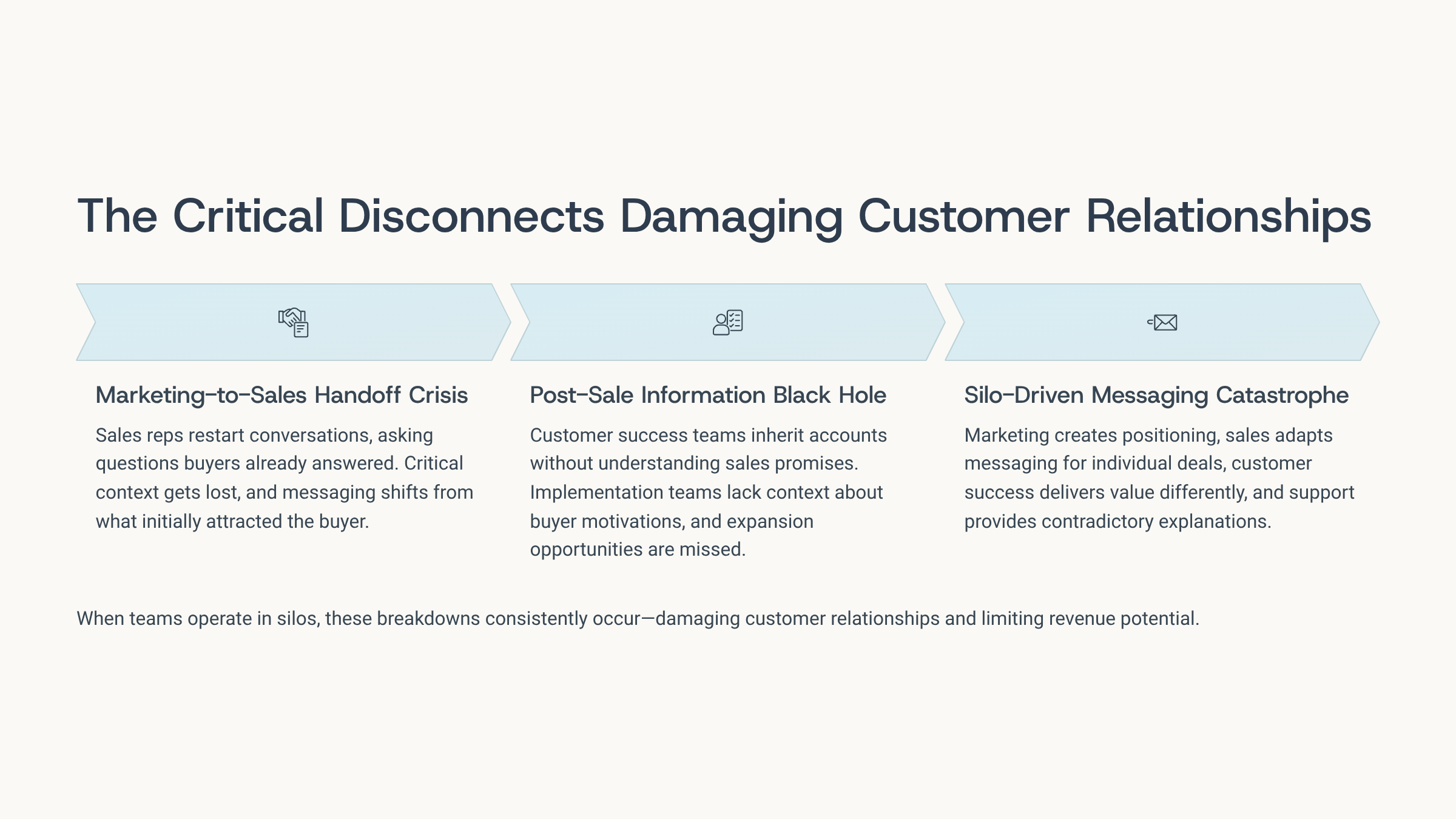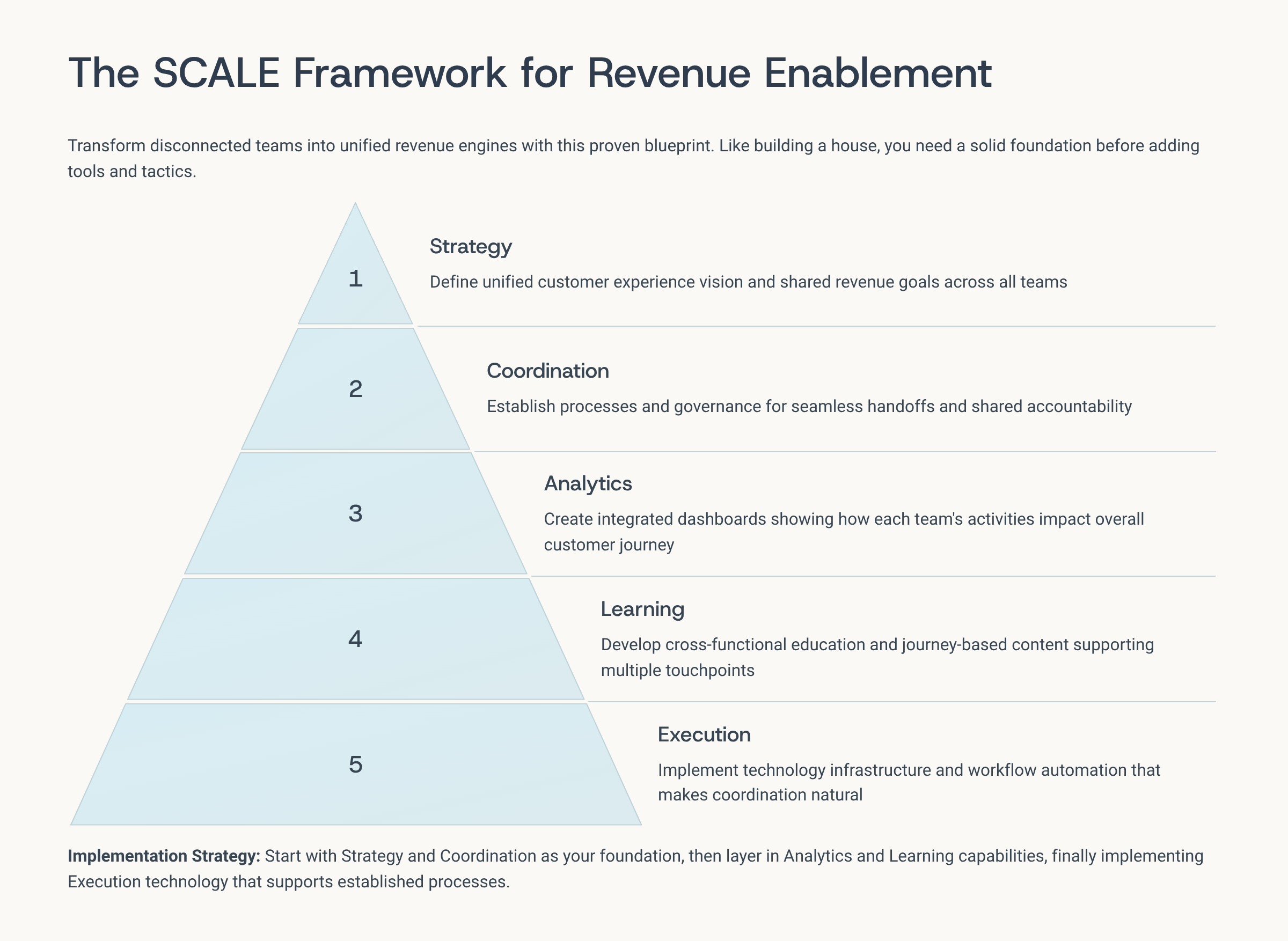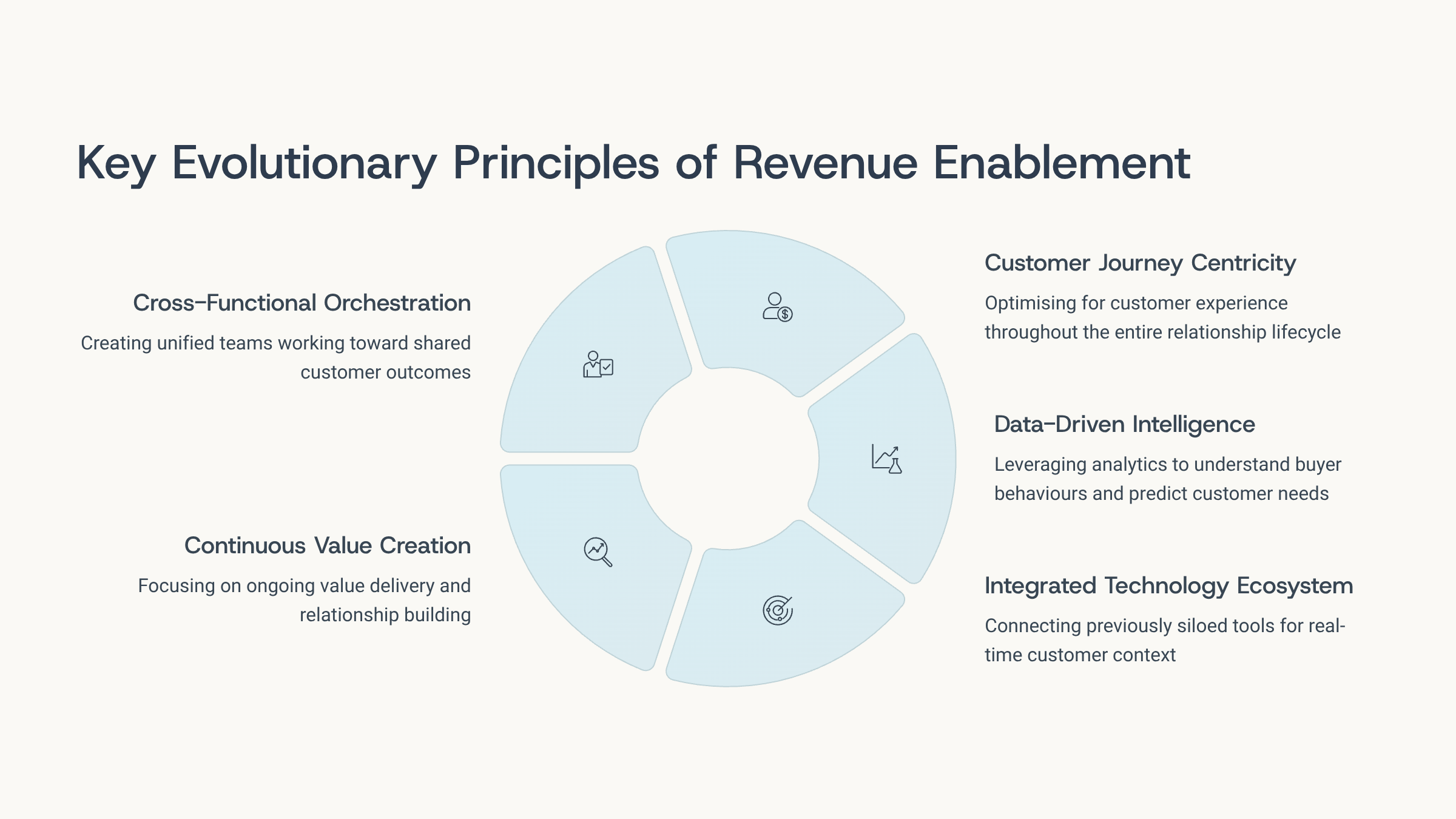Revenue Enablement Platform: Why Sales Enablement Isn't Enough Anymore
Article written by
Kate Williams

INSIDE THE ARTICLE
SHARE THIS ARTICLE
Summary
Revenue enablement platforms represent the evolution from siloed sales training to integrated systems that align all revenue-generating teams around consistent processes, content, and coaching. This guide examines how organizations can evaluate and implement revenue enablement solutions to drive predictable growth through systematic team development, content management, and performance optimization.
Revenue Enablement has been a hot pick since a while. And honestly, it's not hard to see why. Organizations are hitting targets faster, eliminating coordination headaches, and watching revenue climb consistently. But what sparked this evolution? How did smart enterprises recognize that traditional sales enablement wasn't enough and make the leap to revenue enablement? Let's dive into the story behind this fundamental transformation and explore why it's becoming the new standard for sustainable B2B success.
What is Sales Enablement?
For the past two decades, sales enablement has been the backbone of enterprise growth strategies. At its foundation, it's a systematic approach designed to arm sales teams with everything they need to engage prospects and close deals effectively.
The key components of traditional sales enablement includes:
- Training & Development: Comprehensive onboarding, product knowledge updates, customer persona training, sales methodology development, and competitive intelligence.
- Content & Resource Management: Sales presentations, product datasheets, email templates, case studies, and proposal templates.
- Technology & Tools: CRM systems, sales engagement platforms, analytics dashboards, and communication tools.
- Process & Methodology: Defined sales stages, opportunity qualification frameworks, deal review processes, and forecasting procedures.
- Historical Success: Sales enablement has delivered measurable wins—reducing new hire ramp time from 6+ months to 3-4 months, increasing quota attainment by 15-25%, and improving content adoption by 40-60%.
Where It Excels: Traditional sales enablement thrives with straightforward products, linear buyer journeys, single-threaded sales, transactional deals, and product-led growth scenarios.
However, the B2B landscape has fundamentally evolved, revealing critical limitations in traditional approaches.
Why Traditional Sales Enablement Falls Short in Changing Market Dynamics
The B2B buying landscape has undergone a seismic shift, and traditional sales enablement is struggling to adapt.
The New B2B Reality
Modern buyers have fundamentally changed how they research, evaluate, and purchase business solutions, creating complexity that traditional sales processes can't handle:
- Buyers conduct independent research across 13+ sources before engaging sales
- 6-8 stakeholders with different priorities are involved in decisions
- 67% of the purchasing journey completes before talking to sales
- Non-linear, multi-threaded buyer journeys have replaced simple funnels
Critical Disconnects
When teams operate in silos, three major breakdowns consistently occur that damage customer relationships and revenue potential:
- The Marketing-to-Sales Handoff Crisis: When marketing generates a lead, critical context gets lost. Sales reps restart conversations with questions buyers already answered, ignore previous engagement history, and shift messaging from what attracted the buyer.
- The Post-Sale Information Black Hole: Customer success teams inherit accounts without understanding sales promises, implementation teams lack context about buyer motivations, and account managers miss expansion opportunities because they don't know the original business case.
- The Silo-Driven Messaging Catastrophe: Marketing creates positioning based on market research, sales adapts messaging for individual deals, customer success delivers value differently, and support provides contradictory explanations.

The Quantified Cost
The financial impact of maintaining disconnected teams reveals the true urgency behind revenue enablement adoption:
- $1 trillion annually lost in productivity due to poor alignment
- 3-11 hours per week wasted by sales reps searching for content
- 27% lower profit margins from inefficient go-to-market processes
- 60% of buyers report frustrating experiences due to inconsistent messaging
What's Revenue Enablement?
Revenue enablement represents a fundamental paradigm shift from optimizing individual sales performance to orchestrating entire revenue ecosystems for sustainable growth. While traditional sales enablement asks "How can we make our sales team more effective?" revenue enablement poses a transformative question: "How can we create the most valuable customer experience that drives maximum lifetime value across every touchpoint?" This strategic approach provides all customer-facing teams—sales, marketing, customer success, support, and product—with unified tools, resources, training, and insights needed to maximize revenue at every stage of the customer journey, transforming disconnected departments into coordinated growth engines that deliver exceptional customer experiences.
Key Evolutionary Principles
Revenue enablement transforms traditional business operations through five foundational principles that shift organizations from departmental thinking to customer-centric coordination:
- Cross-Functional Orchestration: Creating unified teams working toward shared customer outcomes
- Customer Journey Centricity: Optimizing for customer experience throughout the entire relationship lifecycle
- Data-Driven Intelligence: Leveraging analytics to understand buyer behaviors and predict customer needs
- Integrated Technology Ecosystem: Connecting previously siloed tools for real-time customer context
- Continuous Value Creation: Focusing on ongoing value delivery and relationship building
The Strategic Business Case
Market dynamics have shifted dramatically, making revenue enablement not just advantageous but essential for competitive survival:
- 80% of revenue now comes from existing customers
- Customer acquisition costs have increased 60% over five years
- Buyer expectations for seamless experiences have become the norm
- Competitive differentiation increasingly depends on customer experience
Revenue Enablement Framework
Think of a revenue enablement framework like building a house—you need a solid foundation, clear blueprint, and the right team working together. Most companies jump straight to tools and tactics without establishing the structural foundation that makes everything else work.
The SCALE Framework provides a proven blueprint that transforms disconnected teams into unified revenue engines. SCALE stands for Strategy, Coordination, Analytics, Learning, and Execution—five interconnected pillars that create sustainable competitive advantages.
1. Strategy begins with defining your unified customer experience vision and shared revenue goals across all teams. Instead of marketing focusing on lead generation, sales on deal closure, and customer success on retention, everyone aligns around customer lifetime value and expansion potential. This means creating common definitions for ideal customers, value propositions, and success metrics that every team member understands and works toward.
2. Coordination establishes the processes and governance that enable seamless handoffs and shared accountability. This includes mapping every customer touchpoint, defining clear ownership for each interaction, and creating communication protocols that ensure no information gets lost between teams. TechFlow discovered 23 different handoff points where context was lost—the coordination pillar systematically addresses each gap.
3. Analytics provides the measurement foundation that drives continuous improvement and informed decision-making. Rather than tracking departmental metrics in isolation, teams monitor integrated dashboards showing how marketing activities influence sales conversations, how sales promises affect customer success outcomes, and how support interactions create expansion opportunities. The goal is creating one source of truth that reveals the complete customer story.
4. Learning encompasses the training, content, and knowledge systems that keep all teams current and coordinated. This goes beyond traditional sales training to include cross-functional education where marketing understands sales processes, customer success knows competitive positioning, and support can articulate business value. Content becomes journey-based rather than department-specific, with materials designed to support multiple teams and customer touchpoints.
5. Execution focuses on the technology infrastructure and workflow automation that makes coordination natural rather than burdensome. The right platforms integrate seamlessly with existing tools while providing unified visibility into customer interactions, automated next-best-action recommendations, and workflow triggers that coordinate team responses based on customer behavior.
6. Framework Implementation Strategy: Start with Strategy and Coordination to establish the foundation, then layer in Analytics and Learning capabilities, finally implementing Execution technology that supports rather than disrupts established processes. Companies that reverse this order—starting with technology—typically struggle with adoption and see minimal business impact.
The framework succeeds because it addresses the human, process, and technology elements simultaneously rather than treating them as separate initiatives. When implemented properly, teams naturally begin working together because the framework makes collaboration easier and more valuable than working individually.

Revenue Enablement vs. Sales Enablement
The fundamental differences between these approaches reveal why forward-thinking companies are making the strategic shift.
Dimension | Sales Enablement | Revenue Enablement |
Primary Focus | Sales team productivity | Cross-functional revenue optimization |
Target Audience | Sales representatives and managers | All customer-facing teams |
Scope of Impact | Pre-sale activities and deal closure | Full customer lifecycle |
Success Metrics | Sales KPIs (quota, deal size, cycle time) | Revenue KPIs (LTV, NRR, retention, growth) |
Content Strategy | Sales-specific materials and playbooks | Journey-based, cross-functional content |
Technology Approach | Sales-focused tools and CRM integration | Unified, cross-departmental platform |
Collaboration Model | Sales + Marketing alignment | Organization-wide revenue team coordination |
Customer Experience | Optimized for sales conversations | Optimized for entire relationship journey |
Revenue Strategy | Maximize deal closure and size | Maximize lifetime value and expansion |
Key Features of a Modern Revenue Enablement Platform
A modern Revenue Enablement Platform is more than just another sales tool—it brings together content, training, analytics, and buyer engagement in one place. With smart AI, seamless integrations, and collaborative workflows, it helps teams work smarter and deliver more personalized, revenue-driving experiences. Let’s look at some of the core features that make it so powerful:
1. Centralized Content Management & Intelligent Asset Delivery
- AI-powered content recommendations based on buyer stage and engagement history
- Real-time content performance analytics across customer journey stages
- Dynamic asset personalization adapting to specific customer contexts
- Version control ensuring all teams use current, approved materials
2. Cross-Functional Training, Playbooks & Systematic Onboarding
- Role-specific learning paths spanning all customer-facing functions
- Microlearning modules with interactive simulations and competency tracking
- Collaborative playbooks guiding customer journey progression across team handoffs
- Continuous education programs adapting to market changes
3. Real-Time Analytics & Revenue Intelligence
- Comprehensive dashboards measuring customer engagement and revenue impact
- Predictive analytics for deal progression, churn risk, and expansion opportunities
- Cross-functional reporting showing how each team contributes to revenue outcomes
- AI-driven insights for strategy optimization and tactical decision-making
4. Deep Integration & Unified Data Architecture
- Seamless connections with CRM, marketing automation, and customer success platforms
- Unified customer data models eliminating information silos
- Automated workflow triggers coordinating actions across teams
- Single source of truth for customer interactions and success metrics
5. Advanced Buyer Engagement & Collaboration Zones
- Digital sales rooms enabling collaborative deal progression
- Mutual action plans with clear next steps for buyers and sellers
- Buyer enablement resources helping customers navigate internal decisions
- Interactive proposal environments accelerating deal closure

How to Approach the Shift: Best Practices
Transitioning from sales enablement to revenue enablement requires a strategic, phased approach that builds momentum while minimizing disruption to existing operations Here are a few best practices for the teams moving from the traditional approach to the modern one:
Phase 1: Foundation Assessment & Strategic Planning
- Conduct comprehensive revenue enablement audit across all customer-facing functions
- Map complete customer journey identifying gaps and handoff failures
- Analyze existing technology stack for integration capabilities
- Secure executive sponsorship and cross-functional buy-in
- Define clear success metrics aligning with business objectives
Phase 2: Framework Development & Team Alignment
- Create revenue enablement center of excellence with cross-functional representation
- Define unified objectives and measurement framework
- Establish governance structure with decision-making authority
- Develop change management plan addressing cultural shifts
- Set organization-wide revenue goals including growth, retention, and expansion targets
Phase 3: Technology Integration & Platform Selection
- Develop integrated technology strategy assessing current capabilities
- Identify platform requirements based on user needs and growth projections
- Implement unified revenue enablement platform starting with pilot programs
- Ensure seamless integration with existing critical systems
- Configure workflows supporting natural team collaboration
Phase 4: Content Strategy & Training Development
- Build unified content ecosystem organized around customer journey stages
- Develop cross-functional training programs with role-specific learning paths
- Create microlearning modules fitting busy schedules
- Implement coaching programs providing ongoing support
- Establish content lifecycle management ensuring materials stay current
Phase 5: Change Management & Adoption Excellence
- Drive cultural transformation communicating vision clearly
- Recognize early adopters and showcase success stories
- Address concerns proactively through open dialogue and training support
- Align incentives ensuring individual goals support collaborative behaviors
- Monitor adoption metrics and intervene quickly when teams struggle
Phase 6: Continuous Optimization & Scaling
- Track leading and lagging indicators showing process adoption and business impact
- Conduct regular reviews with cross-functional teams
- Test new approaches through controlled pilots
- Scale successful initiatives to additional teams and regions
- Build competitive advantages through unique approaches and superior execution
Shifting from sales enablement to revenue enablement can unlock massive growth potential—but only if it’s done right. Too often, companies dive in with good intentions but stumble into avoidable mistakes. From buying tools without a strategy to treating enablement like a checklist instead of a cultural shift, these missteps can stall progress and waste valuable resources. Hence, understanding the common pitfalls upfront ensures you don’t repeat them—and sets your team on the path to true, sustainable success.
Top Revenue Enablement Platforms for 2025
As the revenue enablement landscape continues to evolve rapidly, with organizations seeking platforms that can streamline their sales processes, enhance team performance, and accelerate deal cycles. Here's a comprehensive look at the leading platforms that are shaping the future of revenue enablement.
Enterprise-Grade Solutions
1. Highspot stands out as the market leader with its AI-driven approach to content management and guided selling. With over 100 integrations including Salesforce, Slack, and Microsoft, it has earned widespread praise for its intuitive interface and robust analytics capabilities. The platform's 4.7/5 G2 rating reflects its strong performance in enterprise and high-growth sales environments, particularly excelling in coaching and sales analytics.
2. Showpad takes a unique approach by combining interactive content hubs with comprehensive buyer engagement analytics. Its digital sales rooms feature sets it apart, while real-time coaching capabilities help sales teams improve performance on the fly. Organizations often choose Showpad for its exceptional training features and seamless CRM integrations.
3. Mindtickle offers a comprehensive solution that bridges skill development with practical deal execution. The platform's strength lies in its on-the-job learning capabilities, coupled with AI-enabled recommendations and deep analytics for measuring sales effectiveness. It's particularly popular in regulated and highly competitive industries where thorough training and compliance are critical.
Mid-Market and Versatile Platforms
1. SalesHood delivers enterprise-level reporting with actionable coaching workflows, earning a strong 4.6/5 G2 rating. The platform combines onboarding, sales training, and AI-powered coaching with digital sales rooms and comprehensive analytics, making it ideal for organizations seeking robust coaching capabilities.
2. Allego positions itself as a unified platform that seamlessly integrates sales content, learning, and conversation intelligence. Its "in-the-flow" training approach ensures learning happens when it's most relevant, while real-time buyer engagement insights help teams adapt their strategies dynamically.
CRM-Integrated Solutions
1. Salesforce Enablement provides a natural fit for organizations already invested in the Salesforce ecosystem. The platform leverages deep integration with Salesforce CRM to deliver guidance, coaching, content management, and analytics within a familiar environment.
2. HubSpot Sales Hub offers an all-in-one approach that extends beyond traditional sales enablement to include marketing and service components. With AI-powered forecasting and highly customizable features, it emphasizes usability and effective pipeline management.
Next-Generation AI-First Platforms
The revenue enablement space is witnessing the emergence of innovative AI-first solutions designed for modern sales challenges.
1. Momentum leverages artificial intelligence to enhance deal management and collaborative selling processes. The platform excels at personalizing playbooks, generating meeting recaps, and providing actionable next steps and coaching recommendations. It's gaining significant traction among go-to-market and revenue teams in the SaaS industry.
2. Dock focuses on creating AI-driven personalized workspaces that guide both buyers and sales representatives through the entire customer journey in real time. Its affordable and flexible approach makes it particularly appealing to modern sales teams seeking innovative solutions without enterprise-level complexity.
3. SparrowGenie represents the cutting edge of AI-powered sales enablement, specializing in automated proposal and RFP response generation. The platform functions as a digital sales engineer with smart content retrieval capabilities, dramatically reducing proposal turnaround times from days to minutes. Early adopters consistently highlight three key benefits: rapid implementation, robust AI automation for RFPs and proposals, and integrated sales intelligence that accelerates deal cycles.
Choosing the Right Platform
The optimal revenue enablement platform depends on your organization's specific needs, existing technology stack, and growth stage. Enterprise organizations with complex needs may benefit from comprehensive solutions like Highspot or Mindtickle, while companies seeking CRM integration might prefer Salesforce Enablement or HubSpot Sales Hub. For organizations prioritizing AI-driven automation and modern user experiences, emerging platforms like Momentum, Dock, and SparrowGenie offer compelling next-generation capabilities that can provide significant competitive advantages.
Conclusion
And so, the story of this transformation reveals itself: companies discovered that exceptional customer experiences aren't built by individual departments working in isolation, but by entire organizations moving in harmony toward shared goals. Revenue enablement became the new standard because it solves the fundamental challenge of modern B2B—coordinating complex teams to deliver simple, valuable experiences that customers actually want. The enterprises that embraced this evolution didn't just improve their metrics; they rewrote the rules of customer engagement, turning every interaction into an opportunity to build deeper relationships and drive sustainable growth. This is why revenue enablement has become more than a strategy—it's the foundation for how successful B2B companies operate in an increasingly connected world.
So here’s the question for you: are you ready to stop playing catch-up and start leading the game with revenue enablement? The organizations that take the leap today will be the ones their customers remember, return to, and recommend tomorrow.
Ready to see how AI can transform your RFP process?
Product Marketing Manager at SurveySparrow
A writer by heart, and a marketer by trade with a passion to excel! I strive by the motto "Something New, Everyday"
Frequently Asked Questions (FAQs)
Related Articles

101 Self Evaluation Examples for Sales Teams to Improve Performance

The Essential Guide to RFP CRM Integration: What Actually Works in 2025
